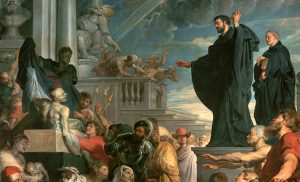 1622-2022. Territories of image. ‘Four Spaniards and a Saint” in the plural Monarchy (16th- 18th centuries)
1622-2022. Territories of image. ‘Four Spaniards and a Saint” in the plural Monarchy (16th- 18th centuries)
Barcelona, Mar 9–11, 2022
Deadline: Oct 4, 2021
The canonization of 1622 marked a turning point in the history of Catholicism, principally because of the group nature of the sanctification. In Rome, on 12th March of that year, the universal worship of five saints was triumphantly declared: Saint Philip Neri, the founder of the Oratorian Order, Saint Teresa of Ávila, the founder of the Order of the Discalced Carmelites, Saint Ignatius of Loyola, founder of the Society of Jesus, Saint Francis Xavier, a Jesuit missionary, and Saint Isidore the Labourer, the Patron Saint of Madrid. This group can be described in various ways: “a saint” and “four Spaniards”; four members of an ecclesiastical order and a secular saint; four men and a woman, etc. How was this plurality received in the Catholic world? What was the response to this universal proclamation throughout the Hispanic Monarchy, which emerged as the great victor? What was the response on an individual scale (at a territorial, local, diocesan or municipal level) right up to the overall perspective within the Empire?
As demonstrated in various recent studies, in the Postridentine period, the image is not just a basic ingredient of worshipping saints, but also a means of configuring, authorizing and disseminating this worship. Therefore, it is important that image is placed firmly at the centre of the reflections generated by this congress. How impact did worship have on imagery and vice versa?
From Barcelona, a medium-populated city within the Hispanic Monarchy, this congress analyses the response and reception in cities to this five-fold canonization by examining the artistic and cultural creations associated with the event: ephemeral celebrations, the relocation of relics, the construction of chapels, miracle plays depicting the lives of the saints, endowments of altarpieces and images, urban developments, urban elements, and so on. The aim was to define the local motors, agents, vehicles and languages within the urban setting, as well as to strengthen the global strategies from the capitals and networks of power. Therefore, the scientific congress is divided into three cross-cutting sections (Settings and celebrations, Images and simulacra, Conflict and arbitrations) that give insight into the dialogue between the different cities, and the expression of the constant negotiations between the Monarchy and the territories that compose it, from Manila to Mexico and spanning Barcelona, Seville, Palermo, Milan, Brussels and Besançon along the way. In this way, it will contribute towards defining the form of polycentrism of which the worship of the saints was the receptacle and expression within the Hispanic Monarchy. The congress examines the images of the canonized saints that were “invented”, copied, projected, disseminated and staged in various formats for different audiences. Despite their plural nature, these images were based on the real portraits of the saints, created and codified in the canonization process. Moreover, the lives of the saints were recounted in series of engravings or paintings, generating original forms of narration.
However, despite historiography’s insistence in this respect, not everything was triumphal in nature. The congress aims to identify the channels of resistance to the triumphalism and universalism that these canonizations expressed, as well as the methods by which consensus and unity was created through them.
The images of modern saints may have competed against each other within certain scenography created for celebrations or because of the canonizations. There may also have been rivalry with worshipping the “old” saints.
Furthermore, the ephemeral decorations and other features of festive celebrations temporally concealed the architectural organization of the city. Ephemeral constructions theatricalized the triumph of the saints for various audiences: how can we define them? How did the ephemeral creations interact with the permanent structures of the social spaces and material in the city? What kind of communities did they generate?
Particular attention will be paid to comparative perspectives, with comparisons focusing on the territories, urban spaces, types of images, decorations, narrative, dissemination, texts, representations, audiences, agents, actors, periods and, of course, saints, in the Postridentine period.
Keywords: cities, centres and peripheries, polycentric, identity and pluralism, image policy, war of images, image geography, local saints and universal saints, ephemeral constructions.
Thematic sections:
Settings and celebrations
– Urbanism
– Ephemeral constructions
– Theatricality
– Audiences
Images and simulacra
– Portraits and attributes
– Visual narratives
– Intermediality
– Endowment of altars, chapels, etc.
Conflict and arbitration
– Wars of images
– Saints in conflict
– Negotiations and arbitrations in the city
– Triumphs and failures
Location:
Two and a half days of congress, which will take place in Barcelona. As far as possible, the organization of the congress will assume the accommodation expenses.
Submission of proposals:
Applicants can submit their proposal until October 4th, 2021 (territoriosdelaimagen@gmail.com). Proposals will include: title, abstract (250-300 words approx.), three keywords and a short bio-biography. Contributions will be published after peer review process.
Organizers:
Sílvia Canalda i Llobet (UB), Sara Caredda (UB-UPF), Ramon Dilla Martí (UB), Cécile Vincent-Cassy (Cergy Paris Université)

Leave a Reply
You must be logged in to post a comment.